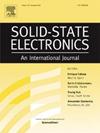Spatially resolved ionization current measurements using an active-matrix transimpedance amplifier array
IF 1.4
4区 物理与天体物理
Q3 ENGINEERING, ELECTRICAL & ELECTRONIC
引用次数: 0
Abstract
In a previous paper by our research group, high-resolution continuous wave (CW) laser spectroscopy was performed on Rydberg states in nitric oxide [1]. Special focus was on the behavior of these states in an electric field with variable strength. In contrast to theory, ionization current measurements show states with no frequency shift for high electric field strengths. Some states seem to split into a shifted and an unshifted line. The reason for this effect is most likely an inhomogeneous electric field distribution. This is caused by field attenuations near the cell walls resulting from charge carrier accumulations on these. Therefore, charge carriers generated near the cell walls experience a much lower electric field than expected. This permanent low-field contribution shows up as an unshifted state in the Stark spectra. To further investigate the charge carrier effects and prove the given explanation, spatially resolved measurements of the ionization currents are performed. These kinds of measurements are enabled by an electrode/transimpedance amplifier array based on thin-film technology. This work shows the realization and characterization of the required thin-film circuits. The focus is on the creation of current-to-voltage converting circuits using amorphous indium gallium zinc oxide as semiconductor. This on-glass electronics enabled spatially and time resolved charge measurements, giving insights into the charge carrier creation and the electric field distribution in the spectroscopy cell. Other thinkable applications of such a sensor array could be the determination of the dynamic density distribution by turbulent gas flow or in resonance-enhanced multiphoton ionization experiments.
使用有源矩阵跨阻放大器阵列的空间分辨电离电流测量
在我们课题组之前的一篇论文中,对一氧化氮[1]中的里德堡态进行了高分辨率连续波激光光谱研究。特别关注的是这些状态在变强度电场中的行为。与理论相反,电离电流测量显示在高电场强度下没有频移的状态。有些州似乎分成了一条移位线和一条未移位线。产生这种效应的原因很可能是电场分布不均匀。这是由细胞壁附近的电场衰减引起的,这是由细胞壁上的电荷载流子积累引起的。因此,在细胞壁附近产生的载流子所经历的电场比预期的要小得多。这种永久的低场贡献在斯塔克光谱中表现为不变的状态。为了进一步研究载流子效应并证明上述解释,对电离电流进行了空间分辨测量。这些测量是通过基于薄膜技术的电极/跨阻放大器阵列实现的。这项工作展示了所需薄膜电路的实现和表征。重点是创造电流到电压转换电路使用非晶铟镓锌氧化物作为半导体。这种玻璃上电子器件实现了空间和时间分辨电荷测量,从而深入了解了电荷载流子的产生和光谱电池中的电场分布。这种传感器阵列的其他可想到的应用可能是通过湍流气流或共振增强的多光子电离实验来确定动态密度分布。
本文章由计算机程序翻译,如有差异,请以英文原文为准。
求助全文
约1分钟内获得全文
求助全文
来源期刊

Solid-state Electronics
物理-工程:电子与电气
CiteScore
3.00
自引率
5.90%
发文量
212
审稿时长
3 months
期刊介绍:
It is the aim of this journal to bring together in one publication outstanding papers reporting new and original work in the following areas: (1) applications of solid-state physics and technology to electronics and optoelectronics, including theory and device design; (2) optical, electrical, morphological characterization techniques and parameter extraction of devices; (3) fabrication of semiconductor devices, and also device-related materials growth, measurement and evaluation; (4) the physics and modeling of submicron and nanoscale microelectronic and optoelectronic devices, including processing, measurement, and performance evaluation; (5) applications of numerical methods to the modeling and simulation of solid-state devices and processes; and (6) nanoscale electronic and optoelectronic devices, photovoltaics, sensors, and MEMS based on semiconductor and alternative electronic materials; (7) synthesis and electrooptical properties of materials for novel devices.
 求助内容:
求助内容: 应助结果提醒方式:
应助结果提醒方式:


